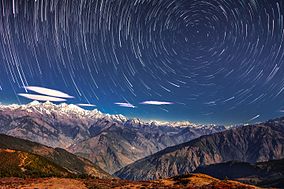Langtang National Park
| Langtang National Park | |
|---|---|
|
IUCN category II (national park)
|
|

Starry night in Langtang National Park
|
|
| Location | Nepal |
| Nearest city | Kathmandu |
| Coordinates | 28°10′26″N 85°33′11″E / 28.1738°N 85.5531°ECoordinates: 28°10′26″N 85°33′11″E / 28.1738°N 85.5531°E |
| Area | 1,710 km2 (660 sq mi) |
| Established | 1976 |
| Governing body | Department of National Parks and Wildlife Conservation, Ministry of Forests and Soil Conservation |
The Langtang National Park is the fourth national park in Nepal and was established in 1976 as the first Himalayan national park. The protected area exceeds an altitudinal range of 6,450 m (21,160 ft) and covers an area of 1,710 km2 (660 sq mi) in the Nuwakot, Rasuwa and Sindhulpalchok districts of the central Himalayan region encompassing 26 Village Development Committees. It is linked with the Qomolangma National Nature Preserve in Tibet. The high altitude sacred lake of Gosainkunda falls within the park. The Gosainkunda lake (4,300 m (14,100 ft)) and the Dorje Lakpa range (6,988 m (22,927 ft)) bisect the park from east–west to south–east. The summit of Langtang Lirung (7,245 m (23,770 ft)) is the highest point in the park.
The northern and eastern border of the national park coincide with the international border to Tibet. The western boundary follows the rivers Bhote Kosi and Trisuli. The southern border lies 32 km (20 mi) north of the Kathmandu Valley.
This protected area represents both Indo-Malayan and Palearctic ecozones.
In 1970, royal approval designated the establishment of Langtang National Park as the first protected area in the Himalayas. The national park was gazetted in 1976 and extended by a buffer zone of 420 km2 (160 sq mi) in 1998. Under the Buffer Zone Management Guidelines the conservation of forests, wildlife and cultural resources received top priority, followed by conservation of other natural resources and development of alternative energy.
...
Wikipedia

